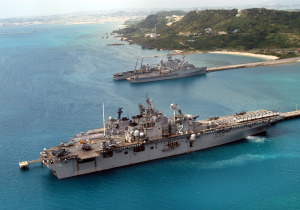Fierce four-way fight in Okinawan Elections
 As the long toil of U.S. elections comes to an end this Tuesday, campaigning just began last Thursday (October 30) for Okinawa’s gubernatorial elections. Unlike America’s months-long ordeal, campaigning only lasts two weeks in Japan – the election will be held on November 16. Okinawa has always been a key component of U.S. grand strategy in East Asia, and local-level elections are drawing international attention yet again as the voters’ choice could have implications for the U.S.-Japan alliance. Because of its proximity to the Taiwan Strait, mainland China and the Korean peninsula, the U.S. military has dubbed Okinawa, “The Keystone of the Pacific.” While strategic considerations dictate a permanent U.S. military presence and Shinzo Abe’s government has signaled its intent to go ahead with the relocation of the military base, the outcome could significantly complicate bilateral planning. For the first time ever, the conservative forces in Okinawa are split – primarily over the issue of having a U.S base.
As the long toil of U.S. elections comes to an end this Tuesday, campaigning just began last Thursday (October 30) for Okinawa’s gubernatorial elections. Unlike America’s months-long ordeal, campaigning only lasts two weeks in Japan – the election will be held on November 16. Okinawa has always been a key component of U.S. grand strategy in East Asia, and local-level elections are drawing international attention yet again as the voters’ choice could have implications for the U.S.-Japan alliance. Because of its proximity to the Taiwan Strait, mainland China and the Korean peninsula, the U.S. military has dubbed Okinawa, “The Keystone of the Pacific.” While strategic considerations dictate a permanent U.S. military presence and Shinzo Abe’s government has signaled its intent to go ahead with the relocation of the military base, the outcome could significantly complicate bilateral planning. For the first time ever, the conservative forces in Okinawa are split – primarily over the issue of having a U.S base.
Incumbent Okinawan Governor, Hirokazu Nakaima, supports the planned relocation of U.S. Marine Corps Air Station Futenma from the city of Ginowan to the Henoko district in the city of Nago and approved the beginning of a landfill project necessary for the relocation last December. Nakaima has the Liberal Democratic Party (LDP)’s official endorsement and pushes for relocation as a realistic option that increases safety for the 100,000 Ginowan residents who live close to Futenma. Though Nakaima originally ran on a platform to push for relocation outside Okinawa, he has changed his position since then, determining that going against the central government will have no benefits.
Running against Nakaima is former Naha (Okinawa’s capital city) mayor, Takeshi Onaga. In the last gubernatorial campaign, Onaga had led Nakaima’s campaign. However, the two political allies are now starkly opposed on how Japan should proceed with the base relocation plans. Formerly the secretary-general of the Okinawan branch of the LDP, Japan’s conservative ruling party, Onaga is now leading a coalition of politicians expelled from the LDP and reformists from the Japan Communist Party and the Social Democratic Party. Onaga wants the base to be relocated out of Okinawa all together. The coalition is rather fragile, however, as some reformists oppose aligning with a former LDP member.
Complicating the picture further is the decision by Komeito (the political wing of mass Buddhist organization Soka Gokkai) to not take a stance and let their party members vote as they personally see fit. Though Komeito is LDP’s junior coalition partner at the national level, the party opposes the relocation. Interestingly, Japan’s biggest opposition party, the Democratic Party of Japan (DPJ), is not fielding a candidate in this election. Shokichi Kina, a former Upper House member also running, was a DPJ member until he was expelled from the party for his anti-relocation stance. Mikio Shimoji, who oversaw postal privatization, is the fourth contender, running on the platform that the issue should be put to a prefectural referendum.
The issue has become intensely emotional, and spiced with a dose of Japan-versus-Okinawa identity politics. In a campaign speech, Onaga vowed to expel the air base, saying, “Seventy-four percent of US military facilities are placed in a small area (Author’s note: Okinawa only makes up 0.6 percent of Japan’s land area). I can never allow that as an Okinawan. That just shows the lack of character on the part of the central government.” The assumption that the relocation must remain within Okinawa also reinforces the “structural discrimination against Okinawa” through the concentration of US bases there.
Even more fundamental than the tension between Okinawa and Japan is the tension between Japan and the US. Though the San Francisco Peace Treaty, which was signed in 1951 and took effect in 1952, restored Japan’s independence, Okinawa was not reverted to Japan until 1972. Even after the reversion, conflicts periodically flared up – especially when Japanese citizens become the victim of crimes by US servicemen. In 1995, a 12-year-old Okinawan girl was gang raped by two marines and a navy corpsman; in 2008, a marine was accused of rape, but the 14-year-old girl later dropped her charge. Accidents are also a source of contention: US aircraft have been involved in 44 crashes on Okinawa since 1972, leaving 84 people dead, injured or missing. A 2004 crash, when a helicopter clipped an administrative building as it crashed into Okinawa International University’s campus, was highly publicized. The most recent accident was a US military helicopter crash on August 5, 2013.
The central government is trying to help Nakaima’s reelection bid by promising to reduce Okinawa’s burdens. Though it hopes to end operations at the Futenma base by February 2013, observers are criticizing it as a “hollow promise” because the U.S. has refused to cooperate. Though the Japanese government has pledged to move ahead with the relocation regardless of the election outcome, a win is essential for Abe as his Cabinet has recently been hit by a string of high-profile corruption scandals. The results certainly bear watching.
